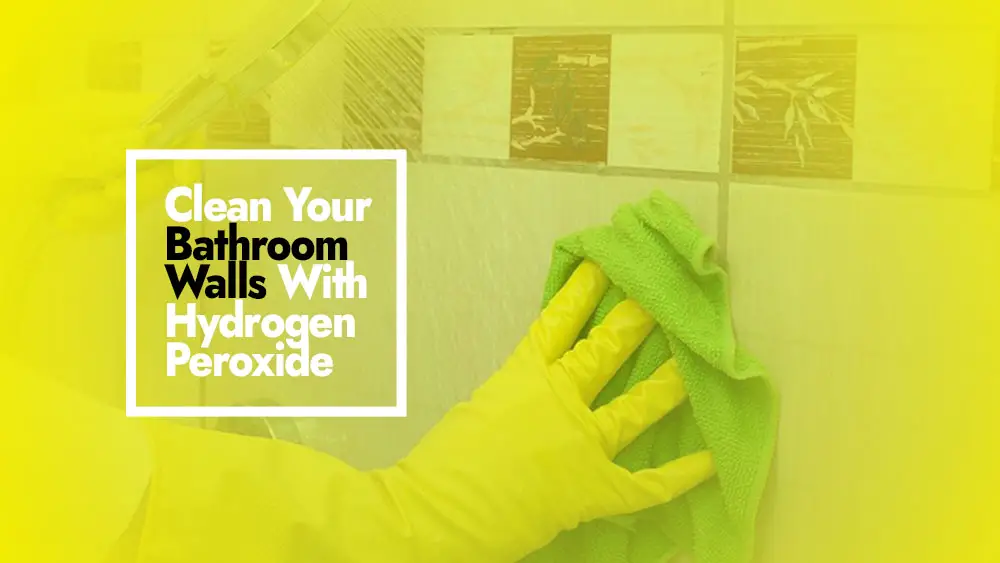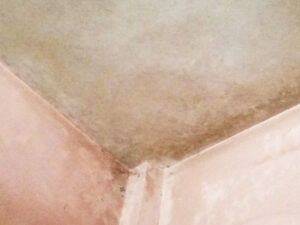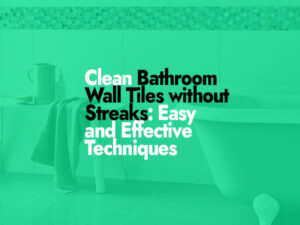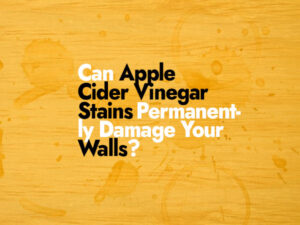I’ve always been very picky about how clean things are, especially in my bathroom. It can be hard to keep the walls clean, in particular. So, I chose to share my tried-and-true method for using hydrogen peroxide to clean bathroom walls. It’s a simple, effective way to get rid of dirt, grime, and spots, and it also cleans and disinfects the surface, leaving it fresh and clean.
In this detailed guide, I’ll show you step-by-step how to use hydrogen peroxide to get rid of those hard-to-remove bathroom wall spots. I’ll tell you why hydrogen peroxide is a great way to clean, how it works, and what you need to watch out for. You’ll learn about the best tools and materials to use, as well as tips and tricks to make the job go more smoothly.
With my personal experiences and tips, you’ll soon know how to make your bathroom walls clean and shiny. So, let’s dive in and find out how to use hydrogen peroxide to get a clean and shiny bathroom!
How to Use Hydrogen Peroxide to Clean Your Bathroom Walls
Hydrogen peroxide can be a good and safe way to clean the walls of a bathroom. Here’s how you can use hydrogen peroxide to clean your bathroom walls:

Step 1: Get your stuff together
Start by getting all the tools you’ll need to clean your bathroom walls with hydrogen peroxide. You will need a bottle of 3% hydrogen peroxide, which you can buy at most drugstores. You will also need a spray bottle, a clean microfibre cloth or sponge, gloves to protect your hands, and safety glasses to protect your eyes.
Step 2: Set up the answer
Once you have everything you need, you can start making the hydrogen peroxide mix. Fill the spray bottle with hydrogen peroxide that has not been dissolved. It’s important to use a 3% concentration because higher amounts can be too strong and damage the walls.
Step 3: Take care of yourself and the area around you
Before you start cleaning, make sure you are safe by putting on some gloves and safety glasses. This will keep the hydrogen peroxide from causing pain to your hands and eyes. Cover any fixtures, like taps or countertops, or surfaces near the walls that you don’t want the hydrogen peroxide solution to get on.
Step 4: Test in a place no one will see
Before putting the solution on the whole wall, it’s always a good idea to test it in a small, out-of-the-way spot. Choose somewhere out of sight, like behind a door or under a towel rack. Spray a little bit of the hydrogen peroxide solution and let it sit for a few minutes. After that, look for any changes in color or damage. If there are no bad effects, you can feel good about moving forward.
Step 5: Spray it and wait
Now it’s time to clean the parts of your bathroom walls that are damaged. Hold the spray bottle a few inches from the wall and spray the hydrogen peroxide solution directly on the spots. Make sure you cover the whole area completely. Let the solution sit for a minute or two. This will give the hydrogen peroxide enough time to get into the dirt, grime, and spots on the walls.
Step 6: Scrub gently
After the solution has had time to work, use a clean microfiber cloth or sponge to gently scrub the walls in a circle motion. Beginning at the top, work your way down. Don’t scrub too hard, because that could damage the paint or wallpaper. Instead, put light pressure on the stains and let the hydrogen peroxide do the hard work of getting them out.
Step 7: Rinse and dry
It’s important to rinse the walls after scrubbing to get rid of any leftover dirt. Fill a bucket or other container with clean water and use a different microfiber cloth or sponge to dampen it. Wipe the walls down with the wet cloth, making sure to get rid of any hydrogen peroxide that is still there. Last, take a dry cloth or towel and wipe the walls well to get rid of any extra water.
Step 8: Check and do it again if needed
Once the walls are dry, check them to make sure that all of the spots are gone. If there are still marks that won’t come out, you may need to do the process again on those spots. Spray the hydrogen peroxide solution directly on the tough spots, let it sit for a few minutes, and then gently scrub again. Repeat this step until all of the spots are gone.
After you’re done cleaning, don’t forget to throw away the gloves and clean your tools. By carefully following these steps, you can use hydrogen peroxide to clean your bathroom walls and leave them clean, fresh, and looking their best.
FAQs
Can I use hydrogen peroxide to clean any kind of bathroom wall, like one that is painted or one that has wallpaper?
Most bathroom wall surfaces, like painting walls and wallpaper, can be cleaned with hydrogen peroxide without getting hurt. But you need to do a patch test in an area that won’t be seen to make sure it doesn’t cause any coloring or damage. If the test area doesn’t show any bad results, you can move forward with trust. If your wallpaper is fragile or your walls have a special finish, it’s always best to check with the maker or a professional.
Can I clean mold or mildew off the bathroom walls with hydrogen peroxide?
Mold and mildew can be taken off of bathroom walls with the help of hydrogen peroxide. Its natural ability to bleach and kill germs makes it a good choice for dealing with these problems. But if there is a lot or a lot of mold or mildew, it’s best to talk to a professional mold removal specialist. They have the knowledge and tools to handle these problems safely and effectively.
Is it safe to use hydrogen peroxide around kids and animals?
Most people think it’s safe to use hydrogen peroxide around kids and pets, especially when it’s used in small amounts to clean. But it’s best to keep them away from the area being cleaned until the walls are dry, so they don’t touch the walls by chance. Also, make sure there is enough airflow in the bathroom while you are cleaning to avoid breathing in fumes.
Can hydrogen peroxide get rid of spots that are hard to get off the bathroom walls?
Hydrogen peroxide can get rid of soap scum, water spots, and general grime from bathroom walls. But it might not work as well on spots that are oil-based or have been there for a long time. In this case, you might need to try different ways to clean or ask a professional for help.
How often should I use bleach to clean the walls in my bathroom?
How often you use hydrogen peroxide to clean your bathroom walls relies on many things, such as how often you use the bathroom, how humid it is, and your own preferences. As a general rule, most homes should be fine with a full cleaning with hydrogen peroxide every few months. But if you see spots or buildup, it’s best to take care of them as soon as possible so they don’t get harder to get rid of.
Can I use hydrogen peroxide to clean things like tiles or tables in the bathroom?
Hydrogen peroxide can also be used to clean tiles and table tops in the bathroom. But it’s important to think about the material and surface finish. Before using hydrogen peroxide on these surfaces, you should do a patch test to make sure it will work and prevent any harm. When cleaning different surfaces, you should always follow the instructions and suggestions given by the maker.
Can I add other cleaners to hydrogen peroxide to make it work better?
Even though hydrogen peroxide can be used with other cleaning products, it is best to use it on its own. Mixing hydrogen peroxide with things like vinegar or bleach can lead to chemical reactions that could be dangerous or make toxic fumes. Always follow the directions that come with each cleaning product and don’t mix them unless you have to.
Does hydrogen peroxide come with any safety tips or warnings?
Hydrogen peroxide isn’t too dangerous to use, but you should still be careful with it. Wear gloves and eye protection to keep your skin and eyes from getting irritated. Also, make sure there’s enough airflow by opening windows or using fans when you clean with hydrogen peroxide so you don’t breathe in the fumes. Hydrogen peroxide should be kept in a cool, dark place that is away from direct sunlight and sources of heat. It should also be kept out of reach of children.
Can hydrogen peroxide be used to clean the bathroom walls of hard water stains?
Yes, hydrogen peroxide can be used to get rid of hard water spots on bathroom walls. Its oxidizing qualities can help break down and remove hard water mineral deposits. Spray the hydrogen peroxide solution directly on the spots, let it sit for a few minutes, and then gently scrub the area. If you need to, repeat the steps until the spots are gone.
Will hydrogen peroxide bleach or change the color of the walls in the bathroom?
Hydrogen peroxide may have a small bleaching effect on some colored bathroom walls, especially if they are fragile or have been in the sun for a long time. Before putting hydrogen peroxide on colored walls, you should test a small area in an unnoticeable place to make sure it doesn’t cause any unwanted discoloration. If you are worried, you could use a cleaner that is made to be gentler on colored surfaces.
Final Thoughts
Cleaning the bathroom walls with hydrogen peroxide is a safe and effective way to keep the bathroom clean and fresh. Getting rid of dirt, grime, and spots on your bathroom walls is easy if you follow the steps in this guide. Hydrogen peroxide can be used to clean many different things because it has natural bleaching and disinfecting qualities. But it’s important to do a patch test and take safety measures to protect yourself and the area around you. With a little work and the power of hydrogen peroxide, you can get your bathroom walls to be clean, cleaned, and shiny, which will make your bathroom look cleaner and better.







